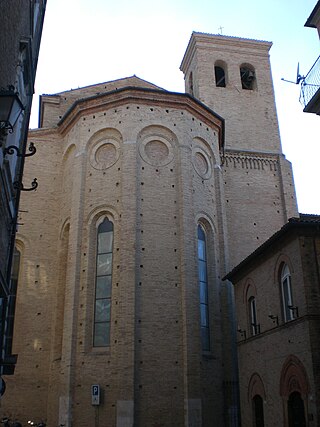
Ancona is a city and a seaport in the Marche region of Central Italy, with a population of around 101,997 as of 2015. Ancona is the capital of the province of Ancona and of the region. The city is located 280 km (170 mi) northeast of Rome, on the Adriatic Sea, between the slopes of the two extremities of the promontory of Monte Conero, Monte Astagno and Monte Guasco. The hilly nature around Ancona is a strong contrast to the flatter coastline in areas further north.

Spoleto is an ancient city in the Italian province of Perugia in east-central Umbria on a foothill of the Apennines. It is 20 km (12 mi) south of Trevi, 29 km (18 mi) north of Terni, 63 km (39 mi) southeast of Perugia; 212 km (132 mi) southeast of Florence; and 126 km (78 mi) north of Rome.

Fano is a town and comune of the province of Pesaro and Urbino in the Marche region of Italy. It is a beach resort 12 kilometres southeast of Pesaro, located where the Via Flaminia reaches the Adriatic Sea. It is the third city in the region by population after Ancona and Pesaro.

Pesaro is a comune (municipality) in the Italian region of Marche, capital of the province of Pesaro and Urbino, on the Adriatic Sea. According to the 2011 census, its population was 95,011, making it the second most populous city in the Marche, after Ancona. Pesaro was dubbed the "Cycling City" by the Italian environmentalist association Legambiente in recognition of its extensive network of bicycle paths and promotion of cycling. It is also known as "City of Music", for it is the birthplace of the composer Gioachino Rossini. In 2015 the Italian Government applied for Pesaro to be declared a "Creative City" in UNESCO's World Heritage Sites. In 2017 Pesaro received the European City of Sport award together with Aosta, Cagliari and Vicenza.

Treia is a town and comune in the province of Macerata in the central Marche (Italy). It is 7 kilometres (4.3 mi) north of Pollenza, 12 kilometres (7.5 mi) west of Macerata, and 18 kilometres (11 mi) north-northeast of Tolentino.

Guastalla is a town and comune in the province of Reggio Emilia in Emilia-Romagna, Italy.

Fermo is a town and comune of the Marche, Italy, in the Province of Fermo.

Cingoli is a town and comune of the Marches, Italy, in the province of Macerata, about 27 kilometres (17 mi) by road from the town of Macerata. It is the birthplace of Pope Pius VIII. It is one of I Borghi più belli d'Italia.
Pioraco is a comune (municipality) in the Province of Macerata in the Italian region Marche, located about 60 kilometres (37 mi) southwest of Ancona and about 40 kilometres (25 mi) southwest of Macerata.

Offida is a comune (municipality) in the province of Ascoli Piceno, in the Italian region of Marche, located about 80 km south of Ancona and about 12 km northeast of Ascoli Piceno, on a rocky spur between the valleys of the Tesino and Tronto (south) rivers. It is one of I Borghi più belli d'Italia.

Osimo Cathedral or the Church of San Leopardo is the principal church of Osimo in Italy, dedicated to the first bishop, Saint Leopardus. Formerly the episcopal seat of the Diocese of Osimo, it has been since 1986 a co-cathedral of the Archdiocese of Ancona-Osimo.

Santa Maria della Piazza is a church in Ancona, central Italy.

Ancona Cathedral is a Roman Catholic cathedral in Ancona, central Italy, dedicated to Saint Cyriacus. It is the seat of the Archbishop of Ancona. The building is an example of mixed Romanesque-Byzantine and Gothic elements, and stands on the site of the former acropolis of the Greek city, the Guasco hill which overlooks Ancona and its gulf.

Porrona is a village in Tuscany, central Italy, administratively a frazione of the comune of Cinigiano, province of Grosseto. At the time of the 2001 census its population amounted to 24.

San Giuseppe da Copertino is a Roman Catholic basilica church in the town of Osimo, region of Marche, Italy.
The following is a timeline of the history of the city of Perugia in the Umbria region of Italy.
The following is a timeline of the history of the city of Ancona in the Marche region of Italy.
The following is a timeline of the history of the city of Arezzo in the Tuscany region of Italy.
The following is a timeline of the history of the city of Pistoia in the Tuscany region of Italy.
The following is a timeline of the history of the city of Trapani, Sicily, Italy.


















